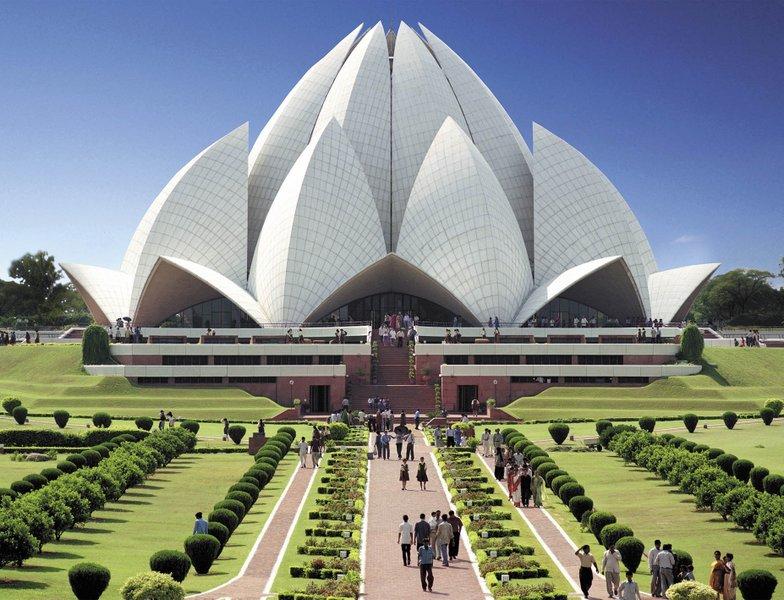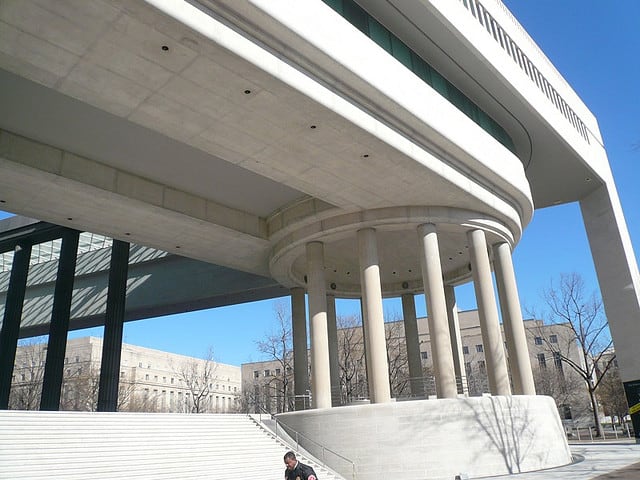Much of the tourism industry focuses on displaying natural wonder, and any housing you encounter is purely in service to the panorama it supports. Sometimes, however, the structures themselves become the attraction, huge or detailed or in some way unique constructions of human imagination and skill. Below are ten must-see buildings for anyone interested in these monuments to human ingenuity.
Mind House - Spain

Probably the most amazing thing about Mind House and the public park that surrounds it, is that it was originally intended for sale as residential space. With two elaborate ginger-bread houses flanking the Disney-styled front gate, this luxury living space would was meant to house the mansions of the Barcelona elite. Though dozens of houses were planned, only two were ever actually built, and one of them is the now-famous Mind House. Today it is a gallery and famous architectural highlight, but it was meant to house an actual family. With rounded edges and finely detailed paint and carpentry work, Mind House is a prime example of the style of architect Antoni Gaudi. The interior is just as unique, with odd angles and bulging ceilings evoking an organic, toadstool feeling. He failed to revolutionize living space, true, but the project's financial collapse caused the Spanish government open it to the public, and it has since become a huge success.
Burj Khalifa – Dubai

The Burj Khalifa isn’t just the latest tallest building in the world - it's by far the tallest. The trend had been to outdo the competition by a few floors, gain the title by a dozen or so metres at a time, the Malaysian Petronas Tower overshadowing the Sears Tower by just 3 metres. The Burj, however, was fully 62 floors taller than its closest rival – and given the difficulties it has faced in paying off its own construction costs, the tower will very likely remain mankind’s tallest structure for quite some time to come. Travellers can benefit from the opulence of its design and construction, however. Just the fountain at the entrance cost the better part of a quarter billion dollars, and can shoot water almost 250 metres into the air. The observation deck, which makes up most of the tower’s 124th floor, provides one of the most breathtaking views mankind has yet devised.
Lotus Temple – India

Located in new Delhi, this Mother Temple of the Baha'i faith has won numerous architectural awards and draws millions of dollars in cultural, architectural, and religious tourism. Last year, the site surpassed both the Eiffel Tower and the Taj Mahal in visitors. In accordance with Bahai custom, the temple contains no pictures, sculptures or recordings, which turns even crowded tours for travellers into a contemplative experience focused on the building’s actual purpose. Additionally, it has no pulpits or altars built in, and those reading to a congregation simply use portable podiums.
Atomium – Belgium

Constructed for Expo ’58 and quickly named one of the strangest buildings in the world, Atomium is a piece of public art first and foremost. It is modeled after the structure of an iron crystal magnified several billion times, allowing visitors to walk through any of the five habitable ‘atoms’. Each has a public display or meeting space of some kind, and many rotate through free exhibitions on a monthly basis. The tubes connecting each room contain escalators to get visitors from place to place. Visits eventually culminate at the top sphere, which provides a 360-degree view of Brussels.
Bibliotheca Alexandrina – Egypt

Located in Alexandria, this library serves double duty as a cultural centre and memorial to one of mankind’s greatest losses. The building was explicitly designed to defy the burning of the original Library of Alexandria, an ancient mega-library burned in the course of three successive wars. The destruction of so much knowledge, much of it totally irreplaceable, spurred the creators of the new Bibliotheca Alexandria to emulate the original’s design and effect. Built out of granite and covered in carvings in more than 120 languages, the library features a 30-metre reading room with glass paneled roof tilted out toward the sea. This cathedral to learning houses almost eight million books, and runs regular tours of its grounds, which are rich with history both real and recreated.
Habitat 67 – Montreal

Habitat 67 is interesting both because of its unique architecture, and because it represents a real attempt to solve a problem for society going forward: how can we have both density and space? As more and more people move to the cities, or have their towns turned to cities around them, the issue of population density begins to threaten the home garden, the second floor porch and the private back yard as social institutions. Habitat 67, with its odd jumble of more than 350 prefabricated concrete rooms, is a wonder to behold, but its clever arrangement of rooms means that every resident has multilevel living, a small and secluded yard and garden, along with the density of living that makes modern urban life possible. This art-deco warren of livable space was built for the 1967 World’s Fair, and its attempt to modernize urban livingspace, apparently quite successful, has been subsequently abandoned by developers.
Palais Ideal - France

Easily the most personal of the entries in this list, Palais Ideal was built over the course of more than three decades by a French postal worker named Ferdinand Cheval. Apparently on a whim, Cheval one day carried a stone home in his pocket after tripping over it on the way home from work. For the next 33 years, he continued bringing home stones, first in his pockets, then eventually in baskets and then wheelbarrows. Working at night by lamplight, Cheval spent the majority of his life slowly building and carving this incredibly elaborate and beautiful work, now preserved by the French government for the public good.
Hallgrímskirkja – Iceland

This landmark Lutheran Church is an icon of the Nordic traditions that laid the foundation for modern Icelandic culture. Built to resemble the great lava flows that so often dot the landscape of the country, the great spire is 75 metres tall and towers over the city of Reykjavik in which it resides. Inside is one of the world’s most powerful pipe organs, an old mechanical thing built into the architecture of the great hall, so its music surrounds humble worshippers with the impression of sheer power. The tower was built to be visible from all parts of the city.
The Eden Project – England

First, forget everything you learned in the movie Biodome. This environmentalist passion project consists of several soft plastic domes maintaining several different environments in the middle of the English countryside. Of the two main domes, one maintains a tropical atmosphere reminiscent of South America, while the other maintains a Mediterranean climate. Each dome houses several thousand species of plants for research, breeding, and just plain preservation. The newly attached Core section includes an education centre aimed at building public awareness of the issues the project was founded to combat. Public tours are available daily.
Canadian Embassy – Washington DC

This is the only member of the list to be nominated as one of the ugliest buildings in the world. Designed by Canadian architect Arthur Erickson, it is a passive-aggressive jab at the American system and building codes, which denied Erickson’s original design for various technical reasons. Most insulting to Erickson was the requirement of pillars – the DC embassy district had bylaws which demanded that all embassies include pillars, so Erickson built a circle of useless pillars in the centre of the embassy lawn. The whole thing is a criticism of “American excess” and it’s become a favourite stop on tours of DC.


